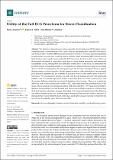| dc.contributor.author | Arquilla, Katya | |
| dc.contributor.author | Webb, Andrea K. | |
| dc.contributor.author | Anderson, Allison P. | |
| dc.date.accessioned | 2022-09-26T11:53:32Z | |
| dc.date.available | 2022-09-26T11:53:32Z | |
| dc.date.issued | 2022-09-17 | |
| dc.identifier.uri | https://hdl.handle.net/1721.1/145560 | |
| dc.description.abstract | The detection of psychological stress using the electrocardiogram (ECG) signal is most commonly based on the detection of the R peak—the most prominent part of the ECG waveform—and the heart rate variability (HRV) measurements derived from it. For stress detection algorithms focused on short-duration time windows, there is potential benefit in including HRV features derived from the detection of smaller peaks within the ECG waveform: the P, Q, S, and T waves. However, the potential drawback of using these small peaks is their smaller magnitude and subsequent susceptibility to noise, making them more difficult to reliably detect. In this work, we demonstrate the potential benefits of including smaller waves within binary stress classification using a pre-existing data set of ECG recordings from 57 participants (aged 18–40) with a self-reported fear of spiders during exposure to videos of spiders. We also present an analysis of the performance of an automated peak detection algorithm and the reliability of detection for each of the smaller parts of the ECG waveform. We compared two models, one with only R peak features and one with small peak features. They were similar in precision, recall, F1, area under ROC curve (AUC), and accuracy, with the greatest differences less than the standard deviations of each metric. There was a significant difference in the Akaike Information Criterion (AIC), which represented the information loss of the model. The inclusion of novel small peak features made the model <inline-formula><math xmlns="http://www.w3.org/1998/Math/MathML" display="inline"><semantics><mrow><mn>4.29</mn><mo>×</mo><msup><mn>10</mn><mn>28</mn></msup></mrow></semantics></math></inline-formula> times more probable to minimize the information loss, and the small peak features showed higher regression coefficients than the R peak features, indicating a stronger relationship with acute psychological stress. This difference and further analysis of the novel features suggest that small peak intervals could be indicative of independent processes within the heart, reflecting a psychophysiological response to stress that has not yet been leveraged in stress detection algorithms. | en_US |
| dc.publisher | Multidisciplinary Digital Publishing Institute | en_US |
| dc.relation.isversionof | http://dx.doi.org/10.3390/s22187034 | en_US |
| dc.rights | Creative Commons Attribution | en_US |
| dc.rights.uri | https://creativecommons.org/licenses/by/4.0/ | en_US |
| dc.source | Multidisciplinary Digital Publishing Institute | en_US |
| dc.title | Utility of the Full ECG Waveform for Stress Classification | en_US |
| dc.type | Article | en_US |
| dc.identifier.citation | Sensors 22 (18): 7034 (2022) | en_US |
| dc.contributor.department | Massachusetts Institute of Technology. Department of Aeronautics and Astronautics | |
| dc.identifier.mitlicense | PUBLISHER_CC | |
| dc.eprint.version | Final published version | en_US |
| dc.type.uri | http://purl.org/eprint/type/JournalArticle | en_US |
| eprint.status | http://purl.org/eprint/status/PeerReviewed | en_US |
| dc.date.updated | 2022-09-22T12:02:07Z | |
| dspace.date.submission | 2022-09-22T12:02:07Z | |
| mit.license | PUBLISHER_CC | |
| mit.metadata.status | Authority Work and Publication Information Needed | en_US |
